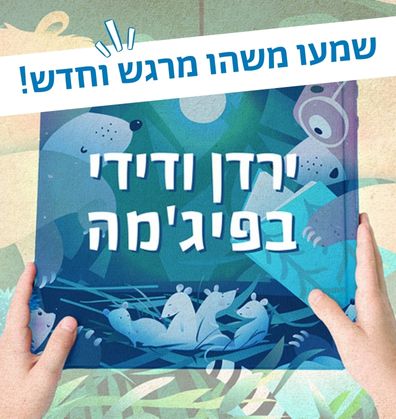כִּשּׁוּרֵי חַיִּים
עידוד קריאה
"פִּתְאוֹם
סוֹף סוֹף
מַרְגִּישִׁים כַּמָּה טוֹב
כְּשֶׁיּוֹדְעִים לִקְרֹא וְגַם לִכְתֹּב!"
(- ע. הלל, לקרוא ולכתוב)
חדוות הקריאה, שמחת הכתיבה והשילוב בין השתיים, מעוררים רגשות נפלאים של הנאה ושל הגשמה. מחשבות הופכות לשירים, רעיונות לסיפורים ועל כל אלו אפשר לקרוא בספרים נפלאים שמעודדים את העיסוק במילה הכתובה, ואת אהבת הקריאה.
סוֹף סוֹף
מַרְגִּישִׁים כַּמָּה טוֹב
כְּשֶׁיּוֹדְעִים לִקְרֹא וְגַם לִכְתֹּב!"
(- ע. הלל, לקרוא ולכתוב)
חדוות הקריאה, שמחת הכתיבה והשילוב בין השתיים, מעוררים רגשות נפלאים של הנאה ושל הגשמה. מחשבות הופכות לשירים, רעיונות לסיפורים ועל כל אלו אפשר לקרוא בספרים נפלאים שמעודדים את העיסוק במילה הכתובה, ואת אהבת הקריאה.
סְּפָרִים
Book-Related Family Activities

Here we go!
It feels good to successfully do something for the first time – reading, writing, and what else? You could discuss memories of “firsts” – theirs or yours – together with your child: scoring a goal, riding a bike, swimming, or solving a riddle. And what else?

Words in illustrations
This book can be read using the illustrations too. You could look for words in them, and try to read them with your child while identifying letters and discovering interesting details added by the illustrator.

Words words
The world is full of words – perhaps you can choose a definition from the book and make a list of words for it: funny words, dancing words, mischievous words, or blossoming words. Words as long as a giraffe, or short ones. Or you may want to make a list of your favorite words.
Discussion
Parents may want to share the stories they liked while growing up: Was there a particular story you enjoyed hearing over and over again? Who was your favorite protagonist? You could ask your child which stories they like. Are they fictional or true stories?
Dual role illustrations
When do the illustrations tell the story of Leo and Mr. Zinger, and when do they complement the story the two of them made up? You may enjoy taking a look at the illustrations together, noticing the various styles, and thinking of ways of discerning what the illustrations refer to, and what they are telling us.
The story in the hat
Which stories are hidden in the hats you own? how about choosing one of your favorite hats and telling the story that is hiding in it: one player looks into the hat and starts inventing a story. After one or two sentences, they pause, and the next player picks up the story, and so on, until all players have added their part to it. Bashevis Singer could serve as a source of inspiration for telling a family story that has been passed down in your family.
A game – Who am I?
Would you like to play a game? Perhaps you would enjoy writing the names of your favorite characters from books on pieces of paper, and taking turns wearing a hat bearing the name of the character. Whoever wears the hat does not see the name written on the piece of paper attached to it, and must guess who it is using questions, such as: Is it a fictional character? Is it an animal?
Discussion
Perhaps you could discuss and share with one another the experiences you recall of moments in which you had discovered a new ability: Writing your first name, a special drawing you had made, and what else? What other new abilities would you like to discover?
Illustrations tell their own story
The illustrations in The Gift invite readers to immerse themselves in the book, and be part of Leo’s world: Which animal accompanies Leo? Which animals appear in the illustrations? Which details are taken from the world of children, and which from that of animals? Would you like to make your own drawing following Leo’s?
What's penned up in your pen?
Which incredible things await you in your pen? You may enjoy dedicating a notebook to drawings, copying words out, or writing down your favorite ones. You could make it a family notebook, in which each member adds their own illustrations and words.
A joint painting
What sort of world is hiding in your pen? Grab a pen and paper to find out! You and your family can take turns adding detail to a shared drawing – a line, circle, character, or item – to create a joint work of art that has come out of a single pen!
Proposed Family Activities:
- You may want to leaf through the book together, and notice the combinations of words and illustrations. Is your child familiar with many of the words comprising Jim’s collection?
- Perhaps you could open a dictionary, or go to Milog at milog.co.il, to show your child just how rich the Hebrew language is. You could even create a family dictionary: decorate a special notebook, adding new and interesting words to it each time. Your child could illustrate the dictionary too.
- You may want to ask your child why they think Jim chose to empty his collection into the wind. Is there anything that makes you particularly happy that you would like to share with others?
- Like Jim, many children enjoy collecting things – pebbles, cards, special napkins from cafes. Did you have a collection as a young child? Share those memories with your child, they may inspire them to continue the family tradition, or start a collection of their own.
- Words are a great way of expressing our feelings. Perhaps you could make notes, write your feelings on them, add a drawing, and stick them on your fridge, front door, or headboard. These notes may be used when we want to express our feelings and cannot seem to find the right words to do so.
- Do you remember any words your child mispronounced when they were just learning to speak? If so, share them with your child, and write them down so that you will never forget.
Look Together
You may want to look at the illustrations together, and compare Gal’s home and kindergarten to the area in which Grandpa Raphael lived so many years ago. Together you may enjoy imagining what your life would have been like had you lived in another place, at another time. If you happen to have old pictures documenting the roots of your own family, you could show them to your child, and try to identify your family members together, as well as the places in which they lived back then, and now.
The Meaning of My Name
Does your child know why they were so named? Having read this book together, you may want to share the meaning of their name with them, and the story leading up to choosing it for them. You could also tell them what made your parents so name you.
Our Village Todgha
Do you know the tune to the song Our Village Todgha by Yehoshua Sobol performed by music group Habreira Hativ’it (The Natural Selection)? Perhaps you would like to sing it together with your child
Remember Together
Just like Gal, many children enjoy listening to stories about the past. Do you remember any festive occasion from your days in kindergarten and school? Perhaps you could share your learning-related childhood memories and family traditions with your child.
Fun with letters
Young children learn from enjoyable activities, such as licking honey-dripping letters. There are many ways of teaching the alphabet: you could put names and words together from various materials, cut out letters from newspapers, identify familiar letters that appear on signs and packages, play word games, and so on. The most important thing is to have fun while you learn!
Have a Great Summer!
Sweet Aleph-Bet is the last book on the PJ Library books list for this year. We hope you have enjoyed the books, and wish you an enjoyable summer, and a smooth beginning in your new kindergarten or school!
A recipe for sweet Aleph-Bet letters
Ingredients:
2/3 cup of soft butter
2/3 cup of sugar
1 egg
1 teaspoon of vanilla extract
2 cups of flour
1 teaspoon of baking powder
½ teaspoon of salt
Method:
- Whisk the butter and sugar until you get a somewhat fluffy batter. Fold in the egg and vanilla extract.
- In a separate bowl, mix the flour, baking powder and salt.
- Combine the two mixtures and knead until dough is crumbly. Knead crumbs into a ball, cover it with saran wrap, and keep refrigerated for an hour.
- Pre-heat oven to medium heat (180°C).
- Flour your worktop and use a rolling pin to flatten your doughball. Use letter-shaped cookie cutters to cut cookies out of the dough.
- Place the cookies on a baking pan, and bake in the oven for 10 to 12 minutes, until edges turn golden.
Suggested Family Activities
- Look through the illustrations accompanying the story, and note the many things Akiva the shepherd knew before he learned to read and write. Then you can remind your children of the many things they know and can do.
- Many Jewish leaders started out as shepherds. You can discuss with your children the tasks involved in shepherding and consider the attributes that characterize a good shepherd. You might ask your child what it is in the essence of the shepherd’s work that helped Rabbi Akiva become a wise teacher and great Jewish leader.
- “One who is shy does not learn” (Avot 2,5): When Akiva saw the signs on the walls of the well and did not know how they were created, he went to the beit midrash (Jewish study hall) for answers. Where do you and your children seek answers to your questions? Are there things that your children know and you don’t? Don’t be shy – ask them!
- You can prepare a clay or Play-Do model of the well with your children. Using a knife or toothpick, you can make signs in the sides of the well – just like in the story.
- Many young children have heard of Rabbi Akiva and his wife Rachel from stories and songs. You can share other tales of Rabbi Akiva with each other and, if you know the tune, sing together “Rabbi Akiva said: Love your fellow as yourself”.
Who was Rabbi Akiva?
Rabbi Akiva, one of the most important sages in Jewish tradition, lived in the land of Israel between the years 17-137 CE. He played a role in editing the Mishna and in designing Halacha, and was the spiritual leader of the Bar-Kochva uprising against the Romans. Many stories and tales were written about Rabbi Akiva, and well-known sayings are attributed to him. One of his more famous sayings is “Rabbi Akiva said: ‘Love your fellow as yourself’: This is a great principle of the Torah” (Breishit Rabba 24,8). According to tradition, Rabbi Akiva was the son of converts and did not learn Torah until he was an adult. The story of his life, like that of other leaders and wise people in Jewish tradition, emphasizes that the Torah is accessible to everyone, even those who didn’t have the opportunity to study when they were young.
The source of the tale about Rabbi Akiva can be found in Avot D’Rabbi Natan 6,2.

Family Activities
You don’t have to stand on your head to see the world upside down! You may want to think together with your child what makes each of us different than others, even “upside-down” in relation to others (appearance, pastimes, opinions, talents, etc.)? How do your family members’ uniqueness and various perspectives contribute to the family as a whole?
You may like to think about the various characters together, and how each one reacts when they discover Shufon’s difficulty. Perhaps you would enjoy creating a dialog between two owls in different points along the book, and discuss with your child the change undergone by the entire owl community.
Sometimes what one person finds hard, another achieves with ease. In order to experience backward reading, you may want to write a word on a piece of paper and put it against a mirror. Look at the word’s reflection. Can you figure out what it says?
Following the story, you may enjoy having a reading ball at home! Each family member can bring their favorite book to the ball, and explain why they had chosen it. You can read the books together, relish the wordplay, and even feast on special refreshments (such as letter-shaped cookies or food associated with one of the books).
Wordplay:
You could look through the book and search for the blue words. Ask your child what sets them apart from the other words in the book, and why they think they were printed in a different color.
You may want to explain to your child that words that read the same left to right and right to left are called palindromes. You may like to think of other palindromes together (such as mom, dad, eye) and enjoy some wordplay.
Some of the words in the book have different meanings when read backwards. You may want to look for these examples and think of other words that create new words when read backwards.

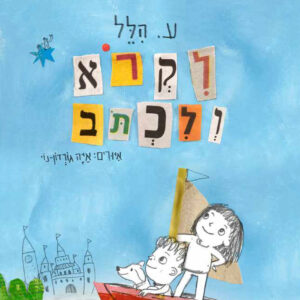 Reading and Writing
Reading and Writing 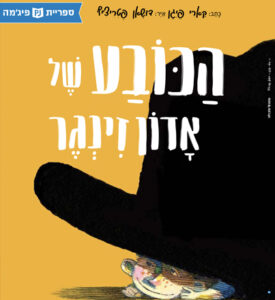 Mr. Zinger’s Hat
Mr. Zinger’s Hat 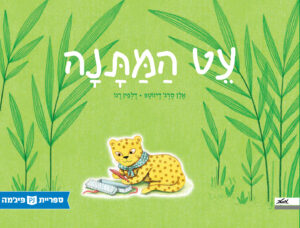 Le Cadeau (The Gift)
Le Cadeau (The Gift) 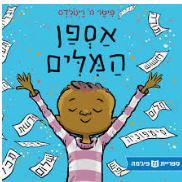 The Word Collector
The Word Collector 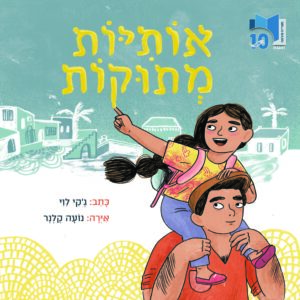 Sweet Aleph-Bet
Sweet Aleph-Bet 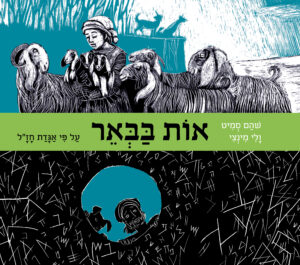 Signs in the Well – Based on a Talmudic tale
Signs in the Well – Based on a Talmudic tale 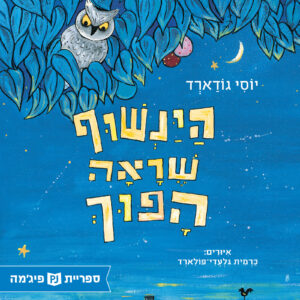 The Backward Owl
The Backward Owl 

